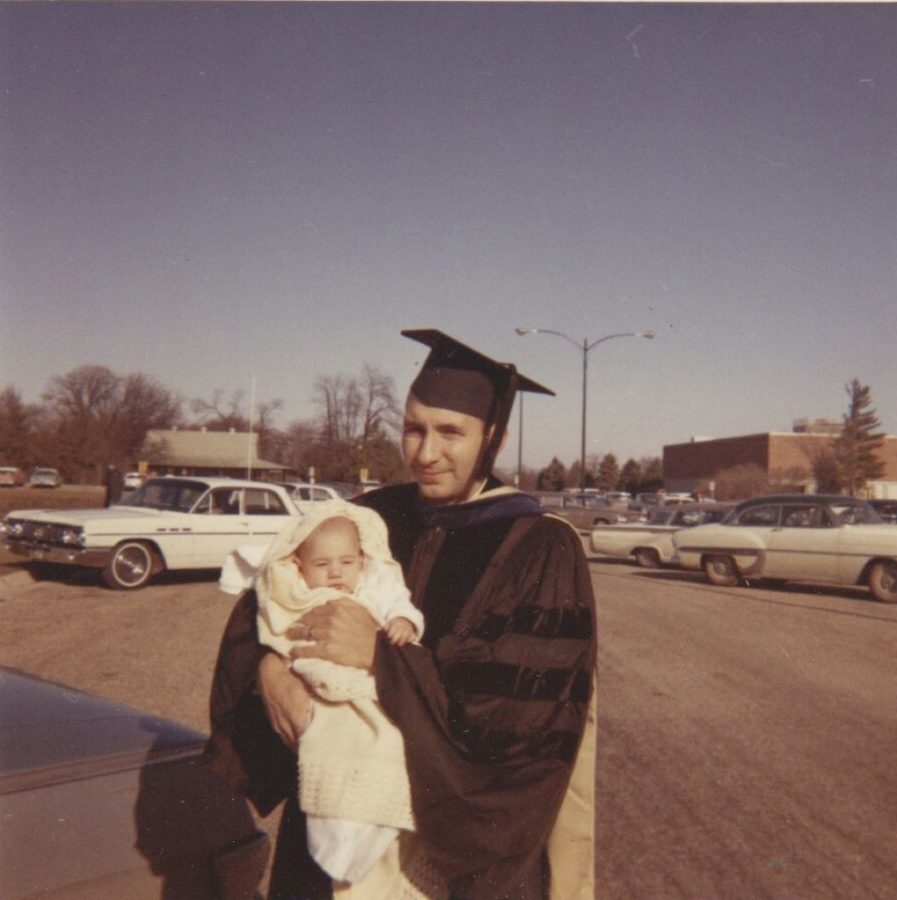Father and son engineers reflect on past, working together at Apple
Photo courtesy of Wendell Sander
Wendell Sander and his son, Brian Sander, in 1963.
November 12, 2017
In 1976, Steve Jobs and Steve Wozniak tested the first Apple computer, the Apple I. Less than a year later, an Iowa State alumni joined their engineering team.
Wendell Sander grew up on a farm in northeast Iowa but felt that farming was not his forte.
“I think that farming just wasn’t quite for me,” Wendell Sander said. “Even as a youngster I was interested in experimenting with things and building stuff. I really had different interests.”
Wendell Sander earned his Bachelor’s degree in electrical engineering at Iowa State in 1956, and eventually earned his master’s degree in 1962 and his doctorate in 1963. After graduating, Wendell Sander worked for Fairchild R&D, a semiconductor company in Silicon Valley, California. The last project Sander worked on there was creating a new kind of memory chip.
“I was looking of some way to test [the memory chip] in the real thing and I saw the Apple I computer. So I bought an Apple I computer and at that time there was just Steve Jobs and Steve Wozniak,” Wendell Sander said. “If I needed to get software or if I had to have it fixed I would call their [customer service] number, which got you ahold of Jobs. So I got to know Steve Jobs through that.”
Wendell Sander met Jobs in person in 1976 when he demonstrated a Star Trek game he had designed for the Apple I. In August 1977, less than a year later, Wendell Sander became the 16th employee for Apple Inc.
About three months into working for Apple, the company was looking to build their engineering department. Wendell Sander became acquainted with Thomas Whitney while in graduate school at Iowa State, and recommended him to Jobs.
“When I was in graduate school, [my family and I] lived in Hawthorn Court which is married student housing,” Wendell Sander stated. “Tom Whitney and his wife were in the same housing group and of course we were both in electrical engineering at the same time. So I knew Tom pretty well.”
Wendell Sander had stayed in contact with Whitney when he moved to California after graduating so he recruited Whitney to work for Apple in 1977. Whitney became an early employee for Apple Inc. as the vice president of engineering.
Whitney and Wendell Sander worked together closely on the Apple II and different Apple projects. Wendell Sander also designed the Apple III during his time at the company, while Whitney was working on a few other projects. However, one of Whitney’s main jobs was recruiting engineers to work for Apple.
Wendell Sander’s son, Brian Sander, was born when Wendell Sander was in graduate school, and the Sander family eventually moved to California. Despite growing up out of state, Iowa State was the only school that Brian Sander applied to for college. Brian Sander graduated from Iowa State University in 1985 with a bachelor’s degree in electrical engineering.
“Iowa State was an awesome place to go to school,” Brian Sander said. “I think [Iowa State] grounded me heavily in the fundamentals, which was really important.”
After graduating, Brian Sander worked for a small start up doing lab work for the most part. Shortly after that, he joined his father’s startup and began to enhance his engineering skills.
While working for his dad’s start-up, Brian Sander did contract work for Apple Inc. and eventually became an employee in 1989. However, the time he spent working there was met with difficulty.
“Apple was still financially stable but was starting to show the cracks of what eventually became a pretty precipitous downfall,” Brian Sander said.
Brian Sander later took a hiatus from Apple, but returned in 2003 to work on the iPod. Wendell Sander returned to Apple during the time Brian Sander worked there. Together they worked on projects regarding the volume controls on Apple earbuds. These earbuds are still sold with all Apple computers today.
Both Brian and Wendell Sander credit Iowa State for their success in the electrical engineering field. Tom Whitney passed away at age 47 in 1986, but his wife has since established a scholarship in his name at Iowa State and remains an active member of the Alumni Association.
“In a lot of cases [students] shouldn’t worry about what exactly they will be doing because it is more important who you are working with and who your mentors are going to be,” Brian Sander said. “I think that’s the key to getting a career jumpstarted- finding the right group of mentors to help and people to learn from.”
















